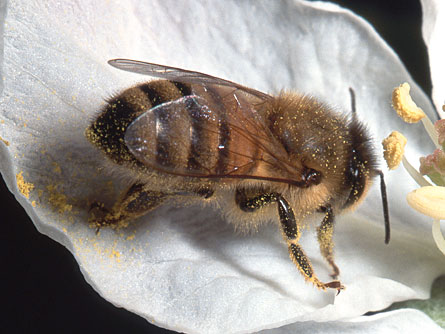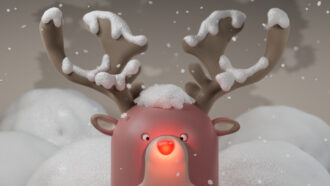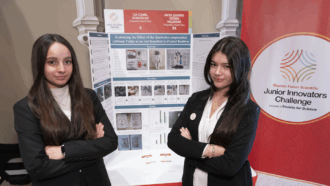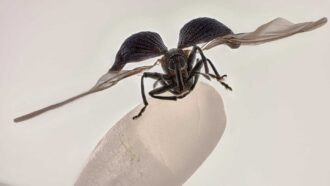Brainy bees know two from three
Honeybees can match patterns by number
Share this:
- Share via email (Opens in new window) Email
- Click to share on Facebook (Opens in new window) Facebook
- Click to share on X (Opens in new window) X
- Click to share on Pinterest (Opens in new window) Pinterest
- Click to share on Reddit (Opens in new window) Reddit
- Share to Google Classroom (Opens in new window) Google Classroom
- Click to print (Opens in new window) Print
By Liz Savage
 |
|
Honeybees have some basic numerical abilities, a new study found. They can recognize a pattern based only on the number of elements in it. For example, if the bees learn to recognize three blue dots, then later they can find three yellow stars, three yellow lemons or three purple blobs.
|
| Jack Dykinga/ARS |
One, two, three…. That’s how high you could count if you were a bee. A new study found that honeybees can recognize a pattern based only on the number of elements in it.
If the bees learn to recognize three blue dots, then later they can find three yellow stars, three yellow lemons or three purple blobs. For such tiny creatures, that’s a big deal.
Many animals — pigeons, raccoons, dolphins, even salamanders — have shown off their numerical abilities in research experiments. But few studies have ever examined invertebrates, like honeybees.
Honeybees are pretty clever.They can tell which items are similar to each other and which are different. They can even count the landmarks they pass on the way to get their food. “I have been studying honeybees since 1980, and I am often surprised by our experimental results. The bee is smart,” says Shaowu Zhang at the Australian National University in Canberra.
Zhang and his team trained about 20 honeybees to fly through a tunnel and into a hole that was marked with either two or three blue dots. On the other side, bees found a chamber with two exits. Each exit was marked with a pattern, either two or three blue dots. If the bees remembered the first pattern and picked the matching hole, the one with the right number of dots, they received a sugary treat. By repeating this training, the bees learned that if they matched the pattern, they would get a reward.
The honeybees may not think about counting “one, two, three” the same way we do. But the bees got their sugar snack about 70 percent of the time. This confirmed for the researchers that the bees were able to detect “sameness,” which earlier studies had suggested.
Then the tests got harder. The scientists wanted to see whether the bees could apply that matching rule to new patterns. The bees might have to match two blue dots to two yellow lemons and later on, three green leaves to three yellow stars. Even in these more difficult tests, the bees could tell the difference between two objects and three.
When they were trained to learn a pattern with three items, the bees could distinguish between three and four items, but couldn’t do the reverse. Given a four-item pattern, the bees could not tell the difference between four and three. Four was too much to keep track of.
Before you decide bees are dumb, you should know that memory studies have suggested that the number of items a person can consciously remember at any one time is around — four.







